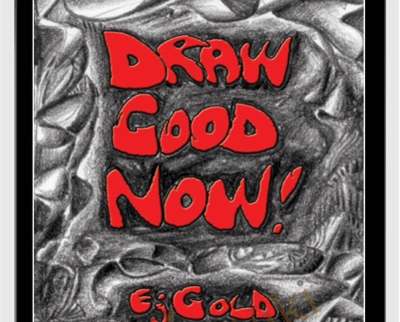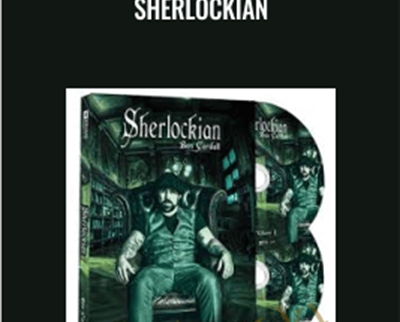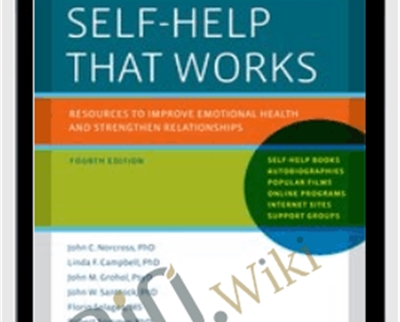Buy Draw Good Now – E.J. Gold Course at GBesy. We actively participate in Groupbuys and are committed to sharing knowledge with a wider audience. Rest assured, the quality of our courses matches that of the original sale page. If you prefer, you can also buy directly from the sale page at the full price (the SALEPAGE link is directly provided in the post).
Salepage link: At HERE. Archive:
$24.95 $11 – Draw Good Now – E.J. Gold
The images in this book comprise a teaching tool created by internationally renowned artist E.J. Gold from which many different exercises and drills utilizing these images were given to class members.
From the Introduction:
The success of the Draw Good Now art series has been spectacular. Who would believe that a classroom of beginners could advance from E.J.’s opening comment — “this is a pencil” to every one of his students becoming selling artists in less than a year? But, that is precisely what has happened. Selling art was the furthest thing from our minds when we signed up for the drawing classes taught by E.J. Gold at a local Ben Franklin Arts and Crafts store. We just wanted to have some fun, learn art, spend a few enjoyable hours with like-minded art enthusiasts, and did I mention have some fun? Because of space limitations and fire code regulations, the class size was limited to fifteen students. It was a historic opportunity for those fifteen of us lucky enough to get into his drawing classes which were always full.
Something about E.J. Gold’s method of teaching was so supportive and encouraging of individual expression that each of the artists in the class managed to first master the basics of drawing, then, miracle of miracles, find his or her own artistic voice. This is an amazing thing to see in seasoned veterans. It is even more delightful to witness in a first year art student. And, this is exactly the vision that each of us was privileged to witness as one after another of the students stepped through this process. There is a humorous story about the three times that Canadians will laugh at a joke. The first time when they first hear it, the second time when they tell it, and the third time when they finally get it. In a similar vein, I believe there are three times that artists appreciate their work. The first time when a trusted friend appreciates it. The second time when a stranger, not your aunt, actually buys your artwork. And the third time when the artist can finally allow himself or herself to appreciate what everyone else knows is good.
Those of us fortunate enough to sign up for the drawing classes taught by E.J. Gold at Ben Franklin’s have appreciated our art these “three times”. And believe me, some of us were definitely a hard sell when it came to our own art.
I had the task of assembling class notes from the various students and compiling them into this introduction. Most of the words come from the notes of my fellow artists. We have tried to capture the flavor of E.J.’s live instructions. In some cases, I believe, we came close. In other cases, we came as close as we could get, given the fact that none of us anticipated the possibility that our classroom scrawls would be finding their way into a book. I guess you just never know for sure to what ben- efit your efforts may serve.
The images in this book comprise a teaching tool created by E.J. Gold for use by class members. During the course of the class many different exercises and drills were given utilizing these images — not the least of which was the “dreaded #11”, but more about that later.
The class framework was immediate, intimate and fluid. Sometimes a bit of encouragement or an invitation to hold the pencil in a slightly different manner was all that was required to midwife a student into a new level of accomplishment. As E.J. frequently pointed out, he did not teach a class, he taught individuals. So while there is a natural progression in drawing, there is not a rigid catechism to be fol- lowed, one robotic step after the other — at least not in the way E.J. taught the Ben Franklin class. And thus, you have the dilemma confronting those of us invited to contribute to this introduction. While it was tempting to concoct a nice progressive stepwise introduction into the use of these Draw Good Now images, that is not how the class was taught. The class was alive and dynamic — mutating with the flux as necessary. And so, we give to you an assemblage of our class notes, organized willy-nilly in our vain attempt to pass along as much as we can from this amazing class. We hope these notes function to give you some insight into the many uses of these images for your work in drawing.
~-~ ~-~ ~-~
Years ago I was visiting New York. I had lunch one day not far from Carnegie Hall. When the waiter came to give me my check, thinking that he might know the local area, I said, “How do I get to Carnegie Hall?”
“Practice, practice, practice,” he replied.
And, that is how it is with drawing. Draw Good Now is a book designed to make the process of “practice, practice, practice” fun and productive to your progress as an artist.
~-~ ~-~ ~-~
Good drawing is the skeletal structure of painting — the foundation of painting. Through the use of the exercises in this book, you will learn more than is apparent, more than is obvious to the eye. For one thing, you will be learning patience and per- ception and a form of memory you’d normally never learn. You may discover how to see. The secret of learning these things is to do the same thing day after day without boredom. Just five minutes a day — every day — is better than one hour once a week.
~-~ ~-~ ~-~
Remember, frustration is part of the learning process. Frustration is an indication that a learning challenge is happening. As an artist, frustration is your friend. Just keep doing the exercises — banging your head against what seems like a wall, until one day the wall isn’t there. The temptation is to avoid the frustration by introducing change. However, the only real change will happen through repetition. Art, though often used for self-expression, is an excellent tool for self-exploration.
~-~ ~-~ ~-~
There is no such thing as a sloppy sketch. “It’s only a sketch” is often used as an excuse for not taking the drawing to completion. To produce a finished drawing requires a special vow to not abandon the piece, to continue with it until it is done. This demands discipline, the kind of discipline that is expected of any professional. Every time you start a piece, state something to yourself like: “I’m going to see this piece all the way through.” Let this be a sacred vow. Even a ten-second sketch demands the artist’s full and complete attention.
~-~ ~-~ ~-~
After a few attempts at drawing, you may discover that exactitude is not truth. After all, you are attempting to put three dimensions on a two-dimensional plane — your piece of paper. Alot of drawing has to do with fooling the eye. Shading is a key ele- ment in “fooling the eye” and creating the illusion of three dimensions. Draw Good Now gives exercise after exercise to help you sharpen your shading skills.
~-~ ~-~ ~-~
Drawing is about mass, not line. The casual eye only sees one thing. The artist’s eye sees masses put together. Lines are used to define boundaries of masses. Creating volume (mass) takes us away from line. Drawing is sculpture on paper.
~-~ ~-~ ~-~
As you draw, coax the drawing along — very gently and patiently. You have to ask, “What do you (the drawing) want to be?” Treat the drawing as a living being. You’re responsible for it, responsible to it. Relax and don’t forget to breathe.
~-~ ~-~ ~-~
Here, I would think it might be a good time to give a short list of supplies and a few tips, such as, the best pencil for the work you will be doing is a 9B. For simple drills and sketches, we would use our Biggie Drawing Pad — (Dick Blick has this to say about the Biggie Drawing Pad: “The Canson Biggie drawing pad is an economical acid-free surface for pencil and charcoal sketching. The pad is tape bound at top with 70 lb (115 gms) sheets in a variety of sizes.”) For more serious drawing, we used the Strathmore 400 Series Medium Drawing Pad. (This natural white paper is ideal for illustrations and final drawings. Ideal surface for any dry media, suitable for pen and ink.) Ben Franklin had these wonderful wooden pencil boxes that would hold up to 12 freshly sharpened pencils ready to use — and this is exactly the way E.J. Gold liked us to work. Continuing to draw with a dull pencil was more than just lazy, it didn’t work to give you the dancing control of the graphite that was necessary for success.
~-~ ~-~ ~-~
He gave us tips such as: Always keep your pencil sharp. Always keep the pencil dancing, moving around the paper. Establish a one-and-a-half inch border before starting your drawing, to give both yourself and your framer a bit of room. Draw on a stack of paper, not directly on a table or bumpy surface. Respect your light source.
~-~ ~-~ ~-~
Don’t let the simplicity of those five little instructions mislead you. The instructions above are so straightforward and simple that they could easily be treated as throw- aways — like the little umbrellas you get with blended drinks — you know, little things that look pretty but don’t require any serious attention. Make them part of your drawing discipline — you will be years ahead of the game.
~-~ ~-~ ~-~
This might be a good place to talk about the game (Domain Solitaire) that E.J. introduced us to.
Domain Solitaire can be played on any basic scribble. We used the Dreaded #11. The drawing was originally entitled #11, simply because it was the eleventh drawing in our workbook. Did we mention yet that E.J. Gold produced these images and had them bound so that we could use them in class as a workbook? Anyway, the first time we worked with the drawing, its title was simply #11. But then after our tenth and twentieth go around with #11, it became known affectionately as The Dreaded #11. It’s recommended that for the purposes of learning Domain Solitaire, you make a photocopy of The Dreaded #11, so that you can follow along with a real example. Somewhere in this book you’ll find a permission to photocopy the images so that you can use them over and over again in your practice.
If you refer to your photocopy of Dreaded #11 you will notice that the basic drawing is composed of a bunch of squiggly lines bounded by a border line. To start the solitaire, select any of the open areas in the drawing. An open area would be any one of the areas inside the bounding border. We found in the begin- ning it was best to start with one of the areas in the upper left. Now using your 9B pencil, fill in the selected area. Try to make the area as uniform as possible — not too light, not too dark. Select a nice mid-tone gray and use that throughout the drawing.
After the selected area is completely filled in, select the next area to work. The rule for selecting the next area is easy in principle. If the current area and the potential new area share a boundary, then that area is not allowed. The next area to be filled in must be catty-corner from the current area. Thus, you’ll need to find a new area to fill in across one of the corners of the current area. If the drawing was a nice, even chess board, it would be obvious which square was catty-corner. In fact, in a chess board, all the catty-corner squares are colored the same.
However, Dreaded #11 is not a nice, even chess board. Sometimes it is a little dif- ficult (but not impossible) to recognize which area is catty-corner. Work your way through it as best you can. No need to obsess. Skill will come only with practice. Repetition is the key — “pencil mileage”. Keep in mind you will be doing over a dozen of these. So it’s no big deal if you don’t quite get the rules down until the second or third attempt.
~-~ ~-~ ~-~
Doing a Scribble — Place your pencil on the paper. Do not lift the pencil until you have finished the scribble. Relax your facial mask, take a breath in, and as you breath out, make your scribble. As you scribble, you can vary the pressure of the pencil as well as the angle and amount of point contacting the paper.
~-~ ~-~ ~-~
As you are drawing lightly — almost not touching the paper, kind of filling it in — you’ll notice, as you draw with soft graphite, slightly darker streaks and blobs. These should be exploited. Allow these naturally occurring light and dark areas to lead you by suggestion. Work with the movement of light and dark across the paper. Treat it like a dance moving in a pattern.
~-~ ~-~ ~-~
You can go in the realm of fantasy. You want to learn to tweak things so the eye is intrigued. Allow the view to participate by leaving some ambiguity. Work on your gray scale. The Dreaded #11 is good for this.
~-~ ~-~ ~-~
The secret of drawing is to establish a light source and stay with it. Work toward a movement of light, a movement of dark, a movement of gray.
~-~ ~-~ ~-~
You are learning relative value in masses. Be patient with yourself, be patient with your object, be patient with your pencil and be patient with your teacher.
~-~ ~-~ ~-~
You have to decide where the light goes or let it happen the way it wants to hap- pen. In graphite, work light to dark and work very gently and softly. If dark is the spice, be very gentle applying the dark. Take it down very gently, a little bit more at a time.
~-~ ~-~ ~-~
Note: If you had the technical know-how to do it, I would suggest creating a device that would say “Don’t forget to breathe” at random moments throughout your drawing practice. While it is true that E.J. didn’t mention this often, each time he did was one of those moments when it seemed like all of us were unconsciously holding our breaths. Not a bad thing to be reminded to breathe every now and then.
~-~ ~-~ ~-~
As a practical matter, if you are right-handed, consider beginning your piece on the left side of the page. This will reduce smudging, since you won’t be dragging your hand over the piece.
~-~ ~-~ ~-~
Don’t be afraid of honest critique. Praise does you no good. You don’t learn from your triumph. You learn from your mistakes. Constructive critique will help you see what you did — Did it work? Can it be improved? Should it have been approached differently?
~-~ ~-~ ~-~
Use the side of your pencil and very lightly draw — like sanding wood with the grain, or raking a path in which you rake along the path — the more gentle you are to the paper, the more gentle the paper will be to you.
~-~ ~-~ ~-~
Let accidents be your guide. Let the piece guide you instead of guiding the piece.
~-~ ~-~ ~-~
Drawing is sculpture on paper. It is not line, it is mass. Everything you’re dealing with in composition is about mass, not line.
~-~ ~-~ ~-~
You don’t capture absolutely every detail when you’re looking at something. Your eyes are the camera, but your mind is not. Sometimes it is often what you don’t put in, what you don’t show, don’t add, what you don’t see, that is more important than what you see. You, as an artist, have the capacity to reduce the information to what you want the others to see.
~-~ ~-~ ~-~
Drawing is a balancing game. You are juggling the entire piece, following every path at once. See the thing in itself — the Gestalt. Imagine finishing just one cor- ner of a raw wood cabinet all the way from rough wood to fine polish, then to stain, and wax, while the rest of the cabinet was still raw wood. This is the not- so-good method of finishing a cabinet. The same goes for drawing. Work the whole piece together.
~-~ ~-~ ~-~
Keep your pencil sharp. When your pencil loses its sharp point, sharpen it. Or work with a pencil easel so that you may have several sharp pencils at the ready. You need a good sharpener. My drawing skills improved by one great leap the moment I accepted that E.J. was serious about working with sharp pencils, and gave it a try. Do yourself a favor and try not to be as stubborn about this as we were. He is serious. Find a pencil that works and keep it sharp. Remember, we worked with 6B to 9B pencils — very soft.
~-~ ~-~ ~-~
Art is not a product, it is a process.
~-~ ~-~ ~-~
Do not hold your pencil as you do when you write or sign your checks. Hold your pencil like a caveman. Or, hold away from the point, like a wand or fencing foil.
~-~ ~-~ ~-~
It is all about exploitation, nudging things very gently and slowly, and looking very slowly. You don’t want line, you want mass. So you want to open the win- dow of perception and have a high attention to see those imperfections. Hold your pencil and wiggle it. Hold it as a wand or fencing foil in a relaxed hand. Your rest- less mind doesn’t let you draw without line. In this, you will see little tiny imper- fect forms that are dimensionally rounded and concave or convex. You decide: “here I see convex with a little shadow, here I see concave.” As I am doing this, new crevices develop and I am massaging shapes that are not line, but actual mass. It’s like Bartok more than Bach.
~-~ ~-~ ~-~
Find the figure by establishing the ground. I am going to establish my figure. I’m going to respect my drawing. I’m going to find the figure and I’m going to do it by defining the background with the same shade. There are boundaries and domains and shared domains.
~-~ ~-~ ~-~
As you are working, you have to see what you’re doing, not only have a sense of it, but have analytical eyes, and see the result of everything you do. And, be aware of the total impact of what you do.
~-~ ~-~ ~-~
Study bark, tree knots, tree holes. Look at things, people, boulders, faces and roads. See more clearly and analytically — you have to let it develop. It knows itself; let it reveal itself to you. Let the drawing develop itself and think in terms of masses. I demand from you that you see masses and do not depend on the line.
~-~ ~-~ ~-~
There you have it. A collection of notes from one or another student jotted down during drawing class. On behalf of all of E.J.’s drawing students, I wish to say that I am grateful for the opportunity to have in hand a guide book that contains all the helpful hints and nuggets of skill-building from that first-year drawing course with E.J. Gold.
In relaying these notes to you, I’ve left the language as close to the original notes as possible, merely adding a verb here and there to smooth over the rough edges. I have deliberately taken this approach in the hopes of preserving the authenticity of the moment as much as possible. In some cases, this allows us to hear the voice of the student. In other cases, we can hear E.J.’s voice making its way past the inac- curacies of note-taking and transcription. All of us from the class hope that these notes are of some service in passing along the heart of those drawing classes. We regret on your behalf that you did not have the opportunity to be there yourself. No matter how many notes we transcribe and pass along, there is no substitute for per- sonal experience personally experienced. His drawing classes were something quite magical. Hopefully, that magic will find its way through these pages to you. I hope to see you at one of E.J.’s coming art workshops and be sure to watch his streaming art instruction videos on hei-art.com.
Claude Needham, Ph.D.
October, 2008
A Reader’s Perspective
“Draw Good Now” is for the begining drawing student and emphasises pencil shading techniques. The student can photocopy or scan the unshaded line drawings then try to reproduce the shaded drawings shown next to them. There are 78 exercises of increasing compexity, starting with simple “scribble” forms. Both foreground and background shading is covered. About half the exercises are of the human body. The remaining subjects are landscapes, portraits and still-life.
I had not drawn much before, except as a child and was delighted to find that when I followed E.J. Gold’s simple steps I could draw. I continue to practice the exercises as often as I can, finding them both pleasureable and relaxing to do.
J.H. (Alberta, Canada)
A Reader’s Perspective
Draw Good Now is the first drawing book I worked with, and it pointed me in the right direction. This is not only best beginner’s drawing book I’ve encountered, it provides an ongoing challenge. The exercises keep on giving and I suspect are a practice for life. EJ’s Draw Good Now method may seem deceptively simple at first glance, but it can be considered as a meditation method that gives direct feedback.
$24.95 $11 – Draw Good Now – E.J. Gold
Buy the Draw Good Now – E.J. Gold course at the best price at GBesy.. After your purchase, you will get access to the downloads page. You can download all the files associated in your order at here and we will also send a download notification email via your mail.
Unlock your full potential with Draw Good Now – E.J. Gold courses. our courses are designed to help you excel.
Why wait? Take the first step towards greatness by purchasing Draw Good Now – E.J. Gold courses today. We offer a seamless and secure purchasing experience, ensuring your peace of mind. With our trusted payment gateways, Stripe and PayPal, you can confidently complete your transaction knowing that your financial information is protected.
Stripe, known for its robust security measures, provides a safe and reliable payment process. With its encrypted technology, your sensitive data remains confidential throughout the transaction. Rest assured that your purchase is protected.
PayPal, a globally recognized payment platform, offers an additional layer of security. With its buyer protection program, you can feel confident in your purchase. PayPal ensures that your financial details are safeguarded, allowing you to focus on your learning journey.
Is it secure? to Use of?
- Your identity is completely confidential. We do not share your information with anyone. So it is absolutely safe to buy the Draw Good Now – E.J. Gold course.
- 100% Safe Checkout Privateness coverage
- Communication and encryption of sensitive knowledge
- All card numbers are encrypted using AES at relaxation-256 and transmitting card numbers runs in a separate internet hosting atmosphere, and doesn’t share or save any data.
How can this course be delivered?
- After your successful payment this “Draw Good Now – E.J. Gold course”, Most of the products will come to you immediately. But for some products were posted for offer. Please wait for our response, it might take a few hours due to the time zone difference.
- If this happens, please wait. The technical department will process the link shortly after. You will receive notifications directly by e-mail. We appreciate your wait.
What Shipping Methods Are Available?
- You will receive a download link in the invoice or YOUR ACCOUNT.
- The course link always exists. use your account to login and download the Draw Good Now – E.J. Gold course whenever you need.
- You only need to visit a single link, and you can get all the Draw Good Now – E.J. Gold course content at once.
- You can do your learning online. You can be downloaded for better results and can study anywhere on any device. Make sure your system does not sleep during the download.
How Do I Track Order?
- We always notice the status of your order immediately after your payment. After 7 days if there is no download link, the system will automatically complete your money.
- We love to hear from you. Please don’t hesitate to email us with any comments, questions and suggestions.
![GBesy [GB] GBesy [GB]](https://www.gbesy.com/wp-content/uploads/2023/05/gbesy-Logo-full-100.png)



 Purchase this course you will earn
Purchase this course you will earn 





Reviews
There are no reviews yet.